
Tembisa was one of the most beautifully hectic experiences of my life. We had to create a 15-20-minute show with singing and dancing, in the short span of three days. All while meeting new people, learning new songs, and trying to fit into a culture that we still weren’t quite used to, even after two weeks of being in South Africa. Throughout the experience, I was never sure that we were going to pull it together. A lot happened in those three days, but I’m going to try to put it all into words as well as I can.
On the first day, Monday, we arrived at the community center to practice our songs. The room we practiced in was a lot smaller than I expected, and a lot fewer people than I expected were singing with us. We went through our usual routine of introducing ourselves, not being able to pronounce anybody’s name, and failing to do their complex and interesting handshakes. It was a little bit awkward at first, but everyone was extremely friendly and comfortable, so we softened up a bit eventually. That was also part of the routine. We met Thulani, the music director, and I was relieved to see that he had a clear vision for the music, since none of us had any idea what we were going to do for the performance.
Thulani had us sing what we knew for him, and he seemed impressed, but our confidence was weakened a bit when he had his choir sing. They couldn’t have had more than 20 people, but they sounded just as big, if not bigger than the other much larger choirs we had heard during the trip. Part of it might have been the small room we were in, but it was clear that there was some serious talent there to help us.
We practiced for almost three hours. It was super fun at first, and it all sounded amazing since their choir was so powerful and we could basically just follow along. Nothing was too difficult, and none of the questions Thulani asked me about the music were too hard to answer. However, towards the end, we hit a huge roadblock. The way we sang the final song, Shosholoza, and the way the Tembisa choir sang it was completely different. Thulani clearly had an idea of how to join our versions together, but he was having a lot of trouble communicating it to us. It was the first time on this trip that I felt like there was a language barrier. We didn’t really figure it out, and even though the rest of the music sounded great, we left Tembisa feeling discouraged and hopeless. I then heard that Thulani was leaving Johannesburg to go do some performance elsewhere, and we weren’t going to have a music director. I had no idea how we would put it all together without him there, and I dreaded coming back for the next day’s rehearsal.
When we returned on Tuesday, our worries only grew when we found out that we had to perform that day, as well as the day after. I had no idea that we were supposed to perform any other day than Wednesday. We didn’t feel prepared at all, even after we practiced a bit beforehand. It turned out that we only had to sing the two easiest songs out of the four we were preparing, but the fact that it was all so new still made it a pretty daunting task.
We walked on stage. Somehow, they managed to fit a stage and at least 100 people in the room we had been practicing in, and the lights drowned out the crowd enough to let us pretend they weren’t there. I wasn’t as nervous as I thought I would be. Maybe the fact that we didn’t really know what we were doing lowered our expectations a little, but I just wasn’t thinking it would go badly at all, and it didn’t. The show went smoothly and we all felt great right after, but there was more for us to watch when we were done.
At that point, we had been in a very different country for a long time, but the culture shock didn’t truly hit me until the show that followed ours. The Tembisan kids stayed on stage, and performed an elaborate and intricate string of musical numbers, dance pieces, and scenes that completely blew me away. I’ve been to a few loud concerts in my day, but the sound from those didn’t even compare to the power of the Tembisa choir. Two of the kids were hitting a couple of drums so hard that I could practically feel myself being blown back by each slap. And it was perfect. Not a single mistake was made. I had to keep remembering to pick my jaw up from off the floor.
Two parts of the show stand out in my memory as being particularly different from anything I’ve ever seen. One was a traditional indigenous dance routine done by three guys and three girls wearing clothing made of hides. The drummers were playing faster than I thought was possible, and the dancers exerted so much energy. Everyone was in tune rhythmically. I don’t know how they were all able to find the same tempo so quickly without looking like they had to think about it. Everyone was in the moment and having so much fun, it was impossible not to smile and do some dorky dance moves in my seat. The other part that stood out to me was on the other end of the emotional spectrum. Two of the kids, a boy and a girl, did an extremely dramatic scene about the death of the baby of the girl’s character. The acting was amazing, and had all of us completely entranced, but the rest of the crowd kept laughing. This was not the type of scene that any of us would’ve ever laughed at, but apparently, everyone else saw it as some type of dark comedy. Surrounded by laughter on an island of confusion, I felt more out of place than ever before. It was clear that I was watching something different from the rest of the crowd, and that feeling is still very hard to describe.
After the show was over, we ate dinner with the Tembisan kids. I talked to one of the drummers, and he taught me a few grooves that he played. Even after I stumbled through them, he insisted that he was impressed with me. I talked with a few more people, and saw more of the same thing. Everyone I met was so talented, but so humble. I realized that most of the people we’ve met don’t like to show off or brag about their talent, because to them, it’s not talent. Music is part of who they are.
The last day was the longest, but the most fun by far. The ice between everyone felt officially broken, and we spent most of the day talking and joking with each other. We ran through the show, making fixes where we could, but Shosholoza still didn’t feel ready. We collaborated as much as we could, but by the end there was a general unspoken consensus that we were just going to wing it.
The performance of the final show might be the most fun I’ve ever had doing a performance of any kind. The crowd was so full of life, clapping and cheering at every opportunity. I couldn’t help but chuckle a little at how exciting it all was. When we sang a South African-ified version of “Stand By Me”, I sang a duet with one of the Tembisan girls named Ellen. The crowd cheered so loudly during it that I could barely hear myself. By the time it was over, I didn’t want to get off the stage, but I had to. We exchanged phone numbers with our new friends, and we got on the bus and left. Even though we had spent the whole day together, it all felt so abrupt. The show ended, and we may never see those crazy talented kids ever again.
This trip has been packed with eye-opening experiences, but our three days at Tembisa might just be my favorite. Looking back, it didn’t feel like only three days. So many things happened with us and those kids, and I feel like I’ve known them for months. They welcomed us into their musical world, and I’ll never forget what that world truly is. Music is the heartbeat of South Africa, and I hope I never stop hearing it.

Arriving at Tembisa, I was nervous for what was to come. We were going to meet a lot of new people our age and perform with them with only three days to rehearse. We were immediately thrown into rehearsal with the choir director, Thulani. When everyone started arriving, we were told to mix in so that we could meet new people. I stood in between two girls, named Ellen and Maya, who I quickly became friends with. We practiced all the songs, sometimes singing our version and sometimes singing their version. By the end of the first day we had a rough idea of what we would be doing.
On the last day of rehearsal, which was also show day, everyone was nervous that the show wouldn’t go well because it still needed a lot of work. We practiced for a few hours and then got to go walk around the surrounding township with our new friends. It was the most fun I had during this whole experience. It was nice to just hang out. It made me wish we had more free time to get to know the Tembisa students better.
When we got back, we did one fuller run through, still making stops to fix things here and there. I was very nervous when the show started but somehow, we did the whole thing with barely any mistakes. It went very well considering the amount of time we had. When it was time to leave, I was sad. I had become close with so many of our new friends and I didn’t want to leave knowing it would probably be the last time, at least for a long time, that I would see them. We gave our final goodbyes and hugs, and waved from the bus until we couldn’t see them anymore. I am going to miss hanging out with all of them. They were so friendly and welcoming that it was easy to become close with them quickly. I could only imagine what would have happened if we had more time together. I look forward to keeping in touch and hopefully seeing some of them again one day.

As our bus made its way through the streets of Tembisa for the second time in as many days, I was completely unsure what to expect. I seem to recall at some point hearing the term “dress rehearsal,” but I was completely unsure what exactly this entailed. All I knew is that, at some point, we would be singing. It was late afternoon, just before dusk, when we arrived at the intercultural exchange. As we entered the relatively small room where the performance was going to take place, I noticed that one end of the room had been transformed into a stage. Levels had been made from stairs and crates painted black, and stage lights hung from missing ceiling tiles. On the stage, our South African counterparts were mid-rehearsal. Their choir was singing softly and, though I could not understand the words, I could feel the power behind them. This singing accompanied a narration, which alternated between various actors and actresses. They were telling the story of Nelson Mandela’s release from Robben island, and the end of apartheid. I was instantly amazed at how passionately the performers on stage embodied their parts, and it wasn’t just the speakers, everybody participated fully. When the speaker described Mandela stepping before the South African crowd, all others whispered and gasped, staring and pointing past the audience, as if Mandela himself was standing in the room. When the speaker described the reaction of the press to Mandela’s release, everyone on stage dropped to their knees and held imaginary microphones to their mouths, chanting a question for Mandela in unison. This served to immerse the audience in the action, and, although it was just a rehearsal, I found myself totally drawn into their performance. Once they were finished, we were invited on stage with them, and we began to rehearse the songs we were performing together: Nkosi Sikelel’ iAfrika and We Shall Overcome. No sooner had we finished than I noticed the room start to fill. We made our way into the audience, and all lights but those illuminating the stage were turned off. Thus, the performance had begun. The show ran nearly an hour past its predicted ending time, but I found that I enjoyed the performances so much that I cared little. There were several pieces that were separate from the songs our group was involved in, including the performance we had walked in on, skits, songs, speeches and dances. There were two such performances that stood out to me as particularly well done, though all were fantastic. The first was a kind of skit portraying an argument between a male character and a female character. They were fighting about the fate of the female character’s baby, and a story began to unfold about a desperate mother without the means to take care of a child she didn’t ask for. I was absolutely blown away by the passion displayed by both performers. I specifically remember looking up at the actress and realizing that she was crying. This was something I had previously thought impossible in live theatre, and yet there she was, tears visibly streaming down her face. I was stunned. It no longer felt as though I was watching a performance, it was as though they had become the characters. The second performance was a Setswana Traditional Dance, which was unique in that it involved costumes. Admittedly, I was initially surprised when the dance began. One moment we were listening to a speech by one of the officials, then suddenly a woman walked on stage carrying what looked like a whip and wearing a skirt mad of animal skins. She began to chant, and she was quickly joined by two other women and four men who were similarly dressed. The group began to sing and dance simultaneously, stomping their feet in time with the drummers who were standing just upstage from the dancers. I was amazed by the precision of their movements. They danced perfectly in rhythm, synchronizing their movements with one another and gliding across the stage with grace that seemed to defy the physical limitations of the human body. It was thrilling to watch. I left Tembisa in awe of the production I had witnessed. I was amazed by the talent and dedication of all the students. In reflection, I feel grateful that I had the opportunity to watch and participate in the show, as well as the opportunity to meet people with such dedication to the thing that makes them happy.
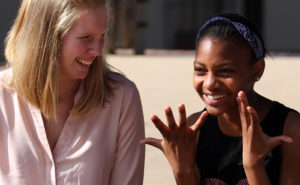
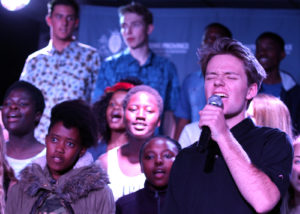
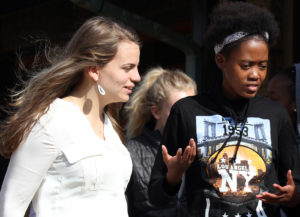
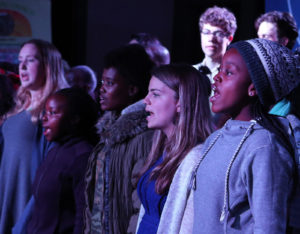
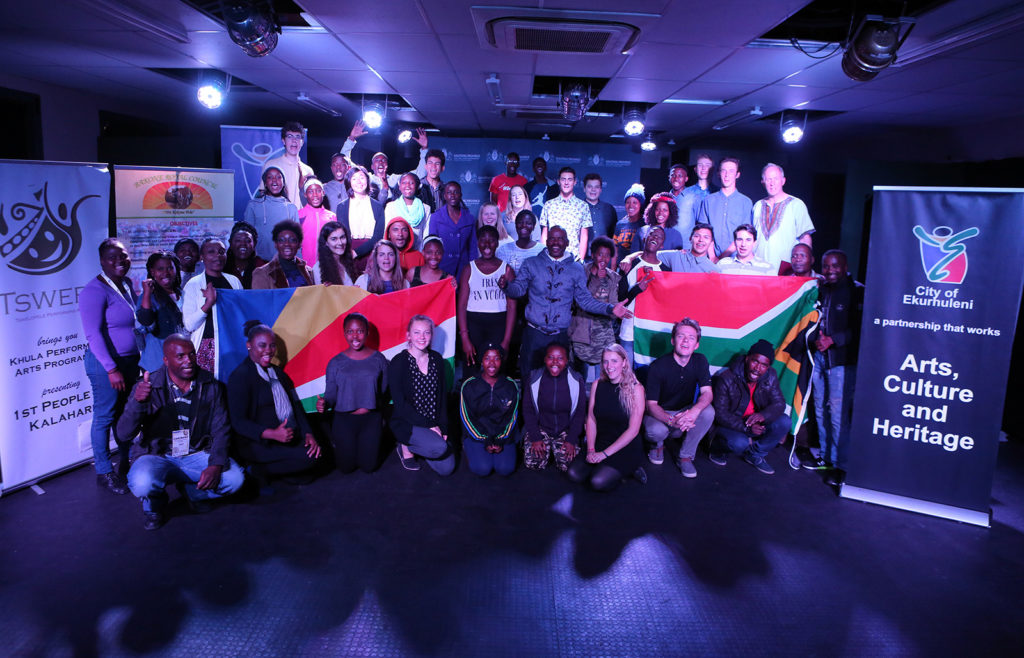
You must be logged in to post a comment.